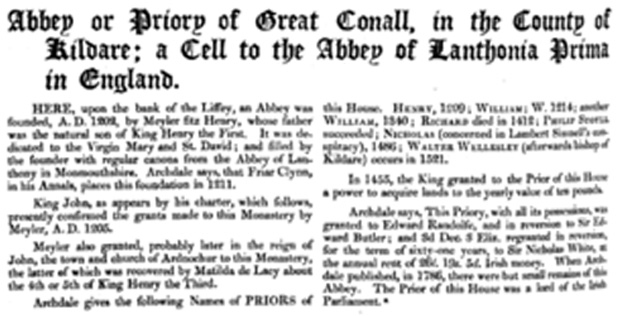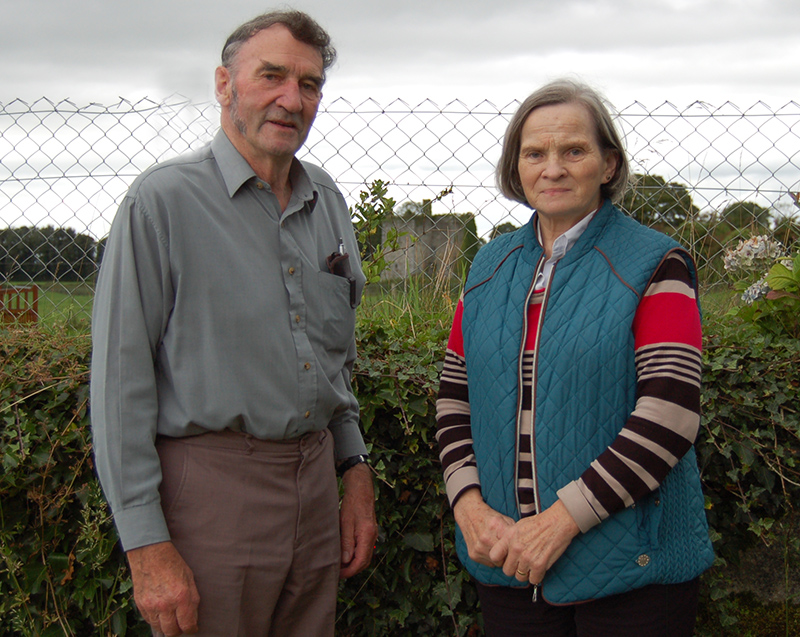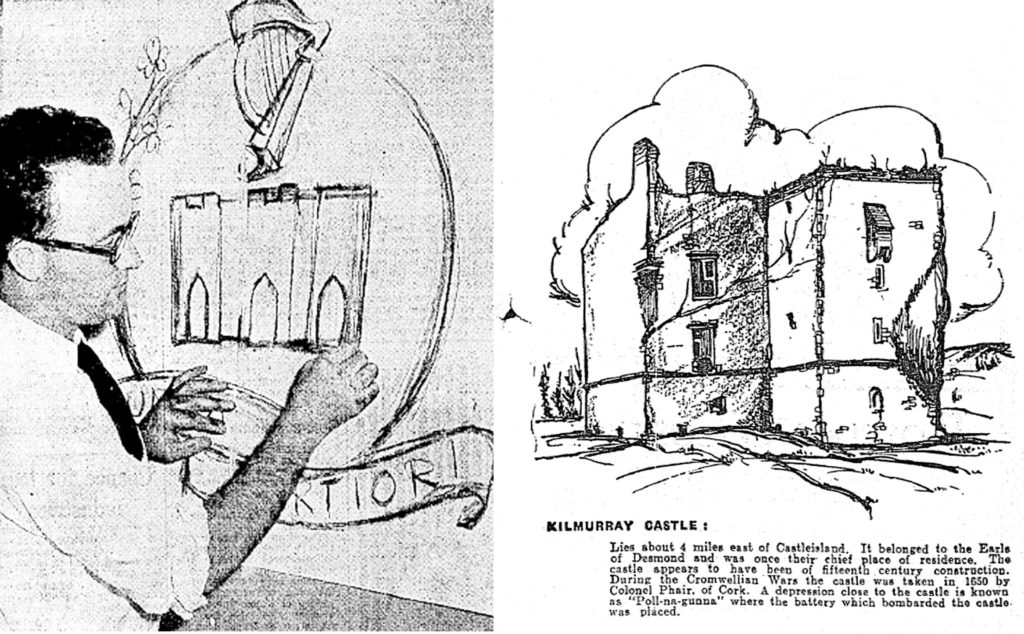For more than 800 years, Kilmurry Castle has stood with its face to the elements. The magnificent ruin finds its roots in regal history, purportedly built in about 1200 by Meiler Fitzhenry, Justiciar of Ireland, after he was granted the northern part of the county of Kerry by King John.[1]
Meiler (or Miles / Meyler) Fitzhenry, credited with the foundation of Dublin Castle, was the son of Henry Fitzroy, illegitimate son of King Henry I of England by Nesta, wife of Gerald of Windsor, and daughter of Rhys ap Tewdwr, King of South Wales.
Meiler died in 1220 and was buried in the priory of Great Conall in Co Kildare, the foundation of which is also attributed to him.

At this distance, Meiler’s life and times in Kerry must remain open to the imagination.
His daughter, Johanna, married Maurice FitzThomas, and had Thomas FitzMaurice Fitzthomas, 1st Lord of Kerry and Lixnaw and from whom the barony of Clanmaurice takes name.[2]
The troubled relationship between the Fitzmaurice family and the Fitzgeralds, Earls of Desmond, may explain how the castle later came into possession of the latter, with whom it was long associated. Indeed, a romantic legend about Patrick Fitzgerald of Kilmurry Castle, and the beautiful Eva O’Connor of Ballymacadam Castle, survives [3]. It relates how both castles were plundered and destroyed in 1650, and how Fitzgerald fled to France with his beloved Eva.

The destruction in 1650 by ‘Fieldfare’, otherwise Colonel Robert Phaire, was on the orders of Cromwell.[4] The events were recorded in the folklore of the area:
Poll an Gunna is the name of one of the fields in the farm attached to Kilmurry House. In this field Cromwell planted the cannon which made the big breach in one of the walls still so much in evidence in Kilmurry Castle.]5]
Indeed, stories about the Fitzgeralds and Cromwell are contained in The Schools’ Collection. One tells how one of the Geraldines was shot by English soldiers and buried in a field near the castle. A long time afterwards, the owner of the field was ploughing and found a golden clasp from what was believed to be Fitzgerald’s coffin.[6]
Another tells of a dream about treasure hidden in the vault of Kilmurry Castle and how three men from the parish spent hours digging there until something frightened them and they abandoned the job: ‘People say that the hole in which they dug is still to be seen.]7]

The romantic ruin inspires both artist and photographer. Images can be found in local histories including Castleisland Church and People and The Castles of the Kingdom of Kerry.[8]
During a residency in Castleisland, UK artist Peter Robin Hill produced an impression of the castle for Divane’s Calendar in 1995.[9] It was also depicted by Dublin artist Peter Weafer who worked for a while in Tralee.[10]

The years roll on and the castle continues to command attention from those who pass by. And all we can do now is gaze in wonder about days past, so long closed to us.
___________________________
[1] The Castles of the Kingdom of Kerry (2004) by Michael J Carroll, p64. Kilmurry (Kilmurray) Castle is also known as Ballycuslane Castle (Ballycushlane, Ballycushlaan, Baile or Bhaile an Chaisleain, Ballinguishlane, Ballyguishlane – see alternative spellings at logainm.ie). [2] The twenty-three Lords of Kerry and Lixnaw are documented on the O’Donohoe website, ‘The Battle of Lixnaw’. [3] Fitzgerald of Kerry A 17th Century Tale of Kilmurry Castle and Ballymacadam Castle (2018). [4] Phaire or Phayre, Governor of Cork. Phaire married as his second wife in 1658 Elizabeth, daughter of Sir Thomas Herbert on Tintern, Monmouth. [5] The Schools’ Collection, Volume 0449, Page 07. [6] The Schools’ Collection, Volume 0449, Page 153. [7] The Schools’ Collection, Volume 0447, Page 040. [8] Castleisland Church and People by Fr Kieran O’Shea (1981), p11; The Castles of the Kingdom of Kerry (2004) by Michael J Carroll, p63. A number of photographs of the ruined Kilmurry Castle, taken in 2019 with kind permission of Marie Walsh, are held in IE MOD/41. [9] O’Donohoe Collection Ref IE MOD/C19. Peter’s work can be viewed at https://www.jazz-whistler.co.uk/section465737.html. See also O’Donohoe webpage, ‘Divane’s Calendar: An Inspired Collaboration’ http://www.odonohoearchive.com/divanes-calendar-an-inspired-collaboration/. [10] Peter Weafer was on the staff of the Kerryman newspaper as a commercial artist. In 1957 (June to December) a series of 24 of his depictions of historic buildings from the county appeared on the front cover of the newspaper under title, ‘Kerry Sketch Book’. They were, in order of publication: Ardfert Cathedral, Ardfert Franciscan Abbey, Rathass Church, Annagh Church, Ross Castle, Fenit Harbour, Ballybeggan Castle, Ballymullen (Castlemorris) Castle, Fenit Castle, Muckross Abbey, Gallerus Oratory, Kilmalkedar Church, Rathanane Castle, Minard Castle, Dunbeg Fort, Ferriter Castle, Lislaughtin Abbey, Ballybunion Castle, Rattoo Monastery, Listowel Castle, Abbeydorney Church, Ton a Cnuig (ancient cross Ballyduff/Lixnaw), Staigue Fort, Kilmurray Castle (a copy of the Kerry Sketch Book is held in the O’Donohoe Collection, ref: IE MOD/41). A one week exhibition of Weafer's work was held in the Grand Hotel, Tralee in November 1957. Weafer subsequently held an exhibition in The Brown Thomas Little Theatre Grafton Street in February 1958. A reviewer wrote, ‘Mr Weafer might well do something notable in the field of black and white illustration. His vignettes of Irish abbeys and castles open up possibilities if the artist could combine the historical record with the pictorial synthesis’ (Sunday Independent, 23 February 1958). Included was one oil, Boats at Chelsea; his pastels included Fille de Paris. Peter Weafer, son of Patrick and Frances Weafer, of North Strand Dublin, was born c1930. He appears to have been one of a family of eight, seven boys and one girl. He studied at the National College of Art until 1955, subsequently studied at St Martin’s School of Art, London and then went to Sweden where he sketched in Stockholm, Store Grummangrand, the Martin Trotzig Canal, Rik’s Bridge, Kolding Castle, etc. Associate of the National College of Art (ANCA). From 1959 to about 1968, he was art teacher at Ballinasloe Vocational School.


